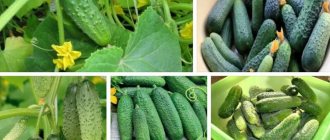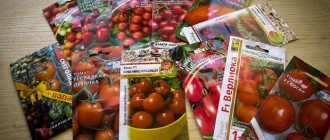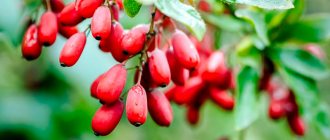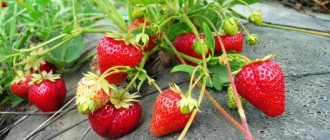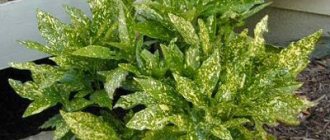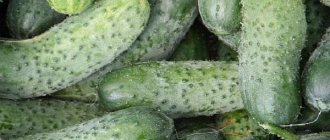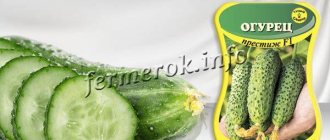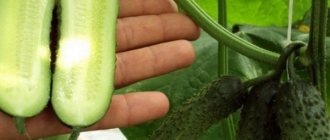The best varieties of cucumbers for pickling and canning for greenhouses and open ground , descriptions and photos of which are presented in this article, are necessary for all gardeners who make preparations for the winter. Not all cucumbers are suitable for pickling and canning. To prepare delicious crispy pickled cucumbers, you need not only a good recipe, but also the right variety of cucumbers, grown according to all the rules of agricultural technology.
Next, you will learn the most popular and best varieties of cucumbers that are suitable for pickling and canning.
How to choose a variety
Long, smooth-skinned cucumbers are good for salads, but not suitable for pickles. Salad varieties are consumed fresh in the summer. When heat treated, the skin softens and the taste deteriorates.
Pickling cucumbers have a large number of tubercles and spines on their skin. When cut, the pulp is dense, with a small number of seeds. They are tasty when collected from the garden, ideal for pickling and various tasty preserves.
The third group includes universal varieties suitable for salads and preparations. They combine the characteristics of the first two groups: the surface is slightly ribbed, with white spines, and the length is slightly inferior to salad greens.
In addition to belonging to groups, the variety is chosen taking into account:
- timing of vegetable ripening;
- taste qualities;
- productivity;
- growing conditions (open beds or shelters).
On sale are varieties bred back in the 20th century, successfully grown in different regions of the country, and new hybrids. The assortment is large, but it is recommended to pay attention to zoned species adapted to a specific area.
Suitable for preservation:
- gherkin varieties;
- cucumbers producing bunched ovaries.
Seeds are selected from the varieties that catch your eye during cultivation. When growing hybrids, you will have to purchase seed material every year.
Features of choosing a variety of cucumbers for pickling
Summer preparations of aromatic crispy cucumbers are a winter table decoration. Experienced housewives know that a successful recipe is not enough to get a tasty product. Not every cucumber is suitable for pickling and canning.
There are three types of cucumber varieties:
- Salad varieties . These cucumbers are fragrant, juicy, and have thin skin. But during heat treatment, the skin and fruit bodies soften, the aroma is lost, and the taste deteriorates.
- Pickling varieties of cucumbers have dense flesh; the skin does not soften under the influence of temperature, allows salt to pass through, and promotes uniform salting of the product.
- Universal varieties of cucumbers are suitable for both salads and pickling.
Salad cucumbers cannot be used for preparations . Only pickling and universal varieties are harvested.
Characteristics of pickling cucumbers
Choosing the right variety or hybrid does not always guarantee success. It is necessary that greens meet certain requirements:
- length – no more than 12-13 cm;
- on the skin there are tubercles (pimples) with spikes;
- taste – slightly sweet, without notes of bitterness;
- pulp – elastic, crispy;
- absence of voids.
Greens for pickling and preservation have a special structure inside; the vessels run transversely, so the flesh is crunchy. Salad varieties do not have this feature; when poured with hot brine or marinade, the pulp becomes soft.
The early ones will yield a harvest in the first half of summer, but for winter supplies you will have to sow cucumbers later or use mid-season and late hybrids. In regions with short summers, cold snaps are common at the end of August, so it is recommended to cultivate vegetables in greenhouses. The greens in the shelter will ripen just in time for the start of salting and preservation for the winter.
How to choose the right cucumbers for pickling?
Before choosing vegetables, it is worth analyzing a large number of factors. In this case, it is worth taking into account the quality of planting material and the weather conditions of the area. The range of vegetables is very large, and therefore it is quite difficult to understand it .
A number of criteria will help determine the quality of vegetables. At the same time, experts advise not to experiment, but to use only suitable and proven varieties. Cucumbers must be of high quality. Yellow or rotten vegetables are absolutely not suitable.
The best pickling varieties
The list starts with proven cucumbers, the “classic” pickles. They are grown throughout the country, successfully compete with new groups, and do not lose ground.
This is interesting!
Gardeners believe that when pickled, “old” varieties have a “real” taste, more aromatic than hybrids.
Many cucumbers from this group served as the basis for the creation of updated series of crops with improved characteristics.
Nezhinsky
Suitable for growing on trellises as it produces long vines. Harvesting greens – 55-70 days. Pollinated by insects. When pickled - excellent taste, crunch. Fruits with large tubercles, dark green color. They reach approximately 10-12 cm in length. Nezhinsky ones are unsuitable for storage; it is necessary to put the greens into processing immediately after harvesting.
Muromsky
Familiar to experienced gardeners, a slightly forgotten variety. Forms powerful bushes with many leaves. The vines are short and are grown spread out on ridges. It withstands cold weather well and is not afraid of drought. Muromskie - short cucumbers, up to 8 cm, pot-bellied, elastic. The skin is light green with characteristic whitish stripes. The aromatic, crispy fruits are suitable for pickling (jars, barrels). “Minus” - they quickly overripe and lose their taste.
Far Eastern
Forms elongated fruits with juicy, dense pulp. It is distinguished by a long period of fruiting and strong growth of vines. It is grown in Siberia, the Far East, and the Urals, showing high yields.
Parisian gherkin
The main advantages of the cucumber beloved by summer residents:
- sweetness;
- crispy pulp;
- unpretentiousness to growing conditions.
Resistant to unfavorable conditions, produces stable yields.
Gherkins up to 10 cm, with dense contents under the skin. There are many tubercles with spikes on the surface, the weight of greens is 90 grams.
Vyaznikovsky
Belongs to the “old guard” of varieties and is cultivated everywhere. Cucumbers are elongated, up to 11 cm, slightly tuberous, aromatic. The core is dense and crunchy.
Fabulous
Elongated cucumbers weighing up to 120 grams, length - 10-12 cm. In terms of timing - mid-early, the first batch is harvested 50 days after the shoots appear. A tasty variety suitable for marinades and pickles.
Coastal
Appeared on the market in the 90s of the last century, mainly cultivated in open ridges. Mid-early, greens are removed after 50-51 days. Triangular cucumbers with blurry whitish stripes, the surface is bumpy, there are no thorns. The fruits are dense, bitter, and there are no voids.
Crisp
It lives up to its name completely; when salted, the flesh remains dense, tasty, and crunchy. Designed for open ground beds, shows good results in tunnels.
It is pollinated by insects and matures in about 50 days. The yields are stable, up to 9 kg per 1 sq. meters. Zelentsy are harvested at a size of 8-10 cm; these are best suited for barrel salting. The skin has large tubercles, a rich dark green color. Gardeners praise the taste of Crispy, noting that the taste only improves when pickled.
Popular cucumbers for winter preparations
Summer residents have their favorites on the list - varieties and hybrids of crops that are distinguished by good growth, friendly yield, and excellent taste.
Hermann
Does not require pollination, productive, unpretentious. Bred in Holland, known on the market since 2001. Gherkins are bright green in color, with small tubercles. Up to 20-25 kg of greens are harvested per square meter of beds.
Hector F1
A popular early cucumber from the group of hybrids. Terms – 30-35 days. The bushes are compact; bundle-type ovaries are formed at the nodes. Resistant to major diseases, dense planting in the garden is allowed. The size of greens is small, 8-10 cm. The surface has large tubercles and white spines. The pulp is crunchy, the taste is juicy, with a pronounced cucumber aroma.
Courage F1
A hybrid of domestic selection, it is distinguished by the power of the bushes and unlimited growth. Parthenocarpic. On the side vines it forms up to 6-8 greens. The fruits are rich green in color with a barely visible bloom, 100-140 grams. The taste is sweetish, with a pleasant aroma.
Phoenix
Productive, late ripening. Recommended for open beds, pollinated by insects. Forms cylindrical greens up to 12-15 cm. The bushes are powerful, with long vines. It bears fruit for a long time; it is advisable to organize systematic harvesting, otherwise the cucumbers will outgrow.
Aquarius
A plant with medium-length vines and powerful pentagonal leaves. It produces oval fruits with many tubercles. The skin has brown pubescence. Length – 12-14 cm, color – green with whitish stripes. The greens are juicy, without bitterness. Harvesting begins on the 50th day, fruiting lasts a long time.
Game
Excellent in pickles and marinades, crispy and tasty. Zelentsy are elongated, no more than 11 cm, 68-72 grams. There are few thorns. Cucumbers ripen in 450-50 days. Harvest dates are extended. Shows good results in shelters and on open ridges.
Moscow Nights
An indeterminate, vigorous hybrid, characterized by resistance to infections and high yield. It forms ovaries in bunches, up to 3-4 greens. The flowers are predominantly female and bear fruit for a long time.
Marinda F1
A productive hybrid of Dutch selection, yielding 25-30 kg per square meter. Self-pollinating, with a stable and stable yield of greens. White-thorned fruits are harvested approximately 40-45 days after emergence. Fruits for a long time. One of the best varieties of cucumbers for preparing for the winter.
Choose - don't yawn!
The list of pickling varieties is huge, so here is a table with the main characteristics of popular cucumbers to help the gardener. This is only a small part of the catalogs of agricultural companies, so any summer resident can still “dig” into the companies’ offers and choose the variety he likes. Perhaps it will become your favorite in pickling.
| Name | Ripening time (days) | Yield indicators (kg/m²) | Purpose | Peculiarities |
| «Courage» | 34-40 | 10-12 | Universal | Parthenocarpic |
| «Green bunch» | 42-45 | 13-5 | Salting, marinating | Requires pollination |
| «Hector» | 33-45 | 5-7 | For salads, pickling, preservation | Bee pollinated |
| «Generous soul» | 43-45 | 14-16 | Universal | New, beam type |
| «Parisian gherkin» | 40-45 | 4-6 | Pickles, preservation | High product characteristics, excellent taste |
| «Amur» | 37-40 | 13-15 | Pickling | Resistant to horse rot, olive spot |
| «Prestige» | 36-44 | 20-25 | Universal | Bred in, it is distinguished by significant productivity. Lezhky |
| «Phoenix» | 55-60 | 4-5 | Pickling | The fruits have white spines. Grows best in open-air garden beds. Needs pollination |
| «Crisp» | 45-50 | 9 | One of the best for pickling in barrels, for pickling | Bee pollinated |
| «Dashing boys» | 43-48 | 10-12 | Recycling | Parthenocarpic |
| «Ksyusha» | 43-45 | 9-11 | Universal | Early ripening and productive |
| «Fragrant strong drinks» | 40-45 | 12-16 | Salting, canning | Early ripening, parthenocarpic. Zelentsy without bitterness |
| «To the neighbor's delight» | 41-43 | 12-14 | For recycling | Bouquet (up to 8-10 ovaries per node) |
| «Morning bouquet» | 45-48 | 12-14 | For recycling | Zelentsy white-thorned |
| «Zelenka» | 40-45 | 10-12 | Marinades, pickling, salads | Fruits with crunch, aromatic, sweetish |
| «Gentlemen of Fortune» | 38-40 | 12 | Pickles, marinades, preservation | Comprehensive resistance to infections |
| «Barrel pickling» | 32-45 | 4-6 | For winter preparations (canning) | High stress resistance |
| «Homemade pickles» | 38-45 | 12-14 | Recycling | Seed germination rate 98% |
| «Dragonfly» | 36-44 | 10-12 | Universal | Bouquet type, parthenocarpic hybrid |
The review presents proven varieties and new hybrids, indicating their advantages and disadvantages. We hope that we have simplified the task of choosing and helped you decide on the fit.
Severova Natalya
Hybrids for pickling and canning
Quite a few hybrid forms of the crop have been bred, designed specifically for conservation and salting. Productive and disease-resistant, hybrid cucumbers are grown in various regions of the Russian Federation.
Lilliputian F1
With proper care for the hybrid, gherkins are harvested from the second half of June. Zelentsy are 7-9 cm, large-tubercular, with small white spines. Ideal for pickling, marinades are delicious. Unpretentious, productive (10-12 kg per 1 square meter), but does not tolerate temperature changes.
Zyatek F1
Early ripening, gives results in greenhouses, bears fruit well in open-air beds. Famous for its excellent taste. The hybrid is easy to grow, as it does not require pollination and bears fruit in any weather. Cucumbers are 12-14 cm, with a large number of tubercles. The thorns are soft, not prickly. Pick greens with pickles and gherkins. Harvest in 40 days.
Siberian salting F1
The hybrid stands out among new breeding products due to its resistance to adverse weather conditions. Bred specifically for risky farming areas, it is unpretentious. Cucumbers are short, 6-8 cm, dense. The skin is light green, the tubercles and spines are small. Genetically without bitterness, the taste is excellent.
Maryina Roshcha F1
A bunch-type hybrid, it begins to yield early. Fruiting periods are long. At the same time, up to 10-12 green gherkins ripen on the bush. Emerald white-thorned fruits are 10-12 cm long, with thick skin and tasty juicy pulp.
Hit of the F1 season
Famous for its abundant fruiting and reliability. Bred by breeders of the agricultural company Manul. Gives greenery until late autumn. Gherkin type, ovaries are formed in bunches, 3-6 pieces each. Side shoots grow intensively, which allows you to extend the harvest time. White-thorned greens, 8-11 cm, high taste.
White sugar F1
An original hybrid with milky-creamy greens. Sweet, dense cucumbers look amazing in assorted jars. The White Sugar variety was developed by Ural breeders and recommended for areas with harsh climates. Ripens in 48-50 days. The fruits are 10-12 cm, with sparse tubercles on the skin. A productive hybrid that does not require complex care.
Among the hybrids, summer residents note the Ginga F1 cucumber and the Little Raccoon F1. From a special selection line of gherkins we will highlight Son of the Regiment F1, Ecole F1, Temp F1, Sankina Love F1.
Features of pickling cucumbers
Advanced gardeners know that not every variety is suitable for harvesting. The division into pickling and salad cucumbers is completely justified, and if you do not follow the recommendations, the jars will “explode” and the vegetables will lose their shape and taste.
Salad varieties and hybrids are usually long, with delicate, smooth and thin skin, rich green in color. Cucumbers for pickles are small, with thick skin, pimply, black-thorned.
On a note! Universal varieties have been developed that are suitable for salads, slicing, and for processing (canning, pickling, pickling). Long fruits for preparations are cut.
The famous crunch of pickled and canned cucumbers is determined by their dense structure and the special arrangement of vascular bundles in the pulp (running from the middle to the edges). Seeds account for no more than 20-22% of the volume of greens. It is believed that for ordinary pickles (water + salt + spices) it is better to choose fruits with black thorns. New hybrids with white pubescence (universal) are also suitable for marinades and canning.
The description on the bag of seeds indicates the purpose of the fruit: consumption only fresh and in salads, processing. Many experienced summer residents have selected the best varieties of cucumbers for pickling and marinades, taking into account the ripening time of the vegetable, regionalization and taste.
But breeders recommend growing not only time-tested cucumbers, but also trying new ones. Productive hybrids are tasty in preparations, have a rich aroma, and high yields.
Some gardeners are skeptical about hybrid forms of culture (F1), believing that real pickles are obtained only from varieties. But this is not entirely true. The experience of summer residents in different regions of the country shows that newfangled hybrids are excellent for processing and provide excellent taste, aroma and the famous crunch.
The best universal varieties: names and characteristics
The category presents varieties and hybrid forms suitable for salads, pickling and canning.
fontanel
An unpretentious hybrid that produces greens in any season. It has excellent taste and ease of cultivation. In shelters they collect up to 22-25 kg per 1 sq. meters, on ridges - up to 10 kg. The fruits do not ripen at the same time, the length is 10-12 cm. There is no bitterness, voids, there is an aroma. When salting, the characteristic crunch remains.
Bush
Early ripening, with compact size, short shoots. Female flowers predominate. Greens are collected every day during the fruiting period, otherwise they will outgrow. Fruits with thick skin, 9-12 cm, tuberculate, black-thorned.
Baby
Small, 7-10 cm cucumbers ripen in 38-40 days. The pubescence is white, with large spiny tubercles located on the dark green skin. Up to 45-50 greens are removed from the bush. Valued for its early ripening, versatility, and immunity to infections.
Zozulya
The variety has been known for more than four decades. It grows in all regions, receiving positive reviews from summer residents. Produces greens up to 20-24 cm long. The pulp is dense, with a large number of small seeds. There is a pleasant aroma. The weaving is weak; in agricultural technology they do without pinching and pinching. For preservation, the fruits are cut into slices.
Tom Thumb
Forms cucumbers without pollination (parthenocarpic), has shown excellent results in greenhouses and on beds. Gives 12-14 kg per 1 sq. meters, bears fruit for a long time (up to 1.8-2 months). Gherkins are 7-9 cm, with small whitish stripes on dark green skin. Taste qualities are rated “excellent”.
Masha F1
Gives harvest in 38-40 days. The fruits are cylindrical, with a very dense skin. Length 7-9 cm, pulp juicy, with crunch. There is no bitterness. From 1 square meter they remove up to 11-12 kg.
On a note!
During the harvest period, cucumbers are picked every day, otherwise they will overgrow.
Competitor
A powerful, bee-pollinated variety. Ripens in 45 days. The greens are lumpy, dark green, with small spines. Grows up to 12-14 cm. Resistant to bacteriosis and powdery mildew.
Reviews from experienced gardeners
On the Garden Design website I found the following reviews about different varieties of cucumbers:
Natalya: November 7, 2013 at 6:04 am Very tasty Connie’s cucumbers. This is a Dutch hybrid. The tubercles are small, the cucumbers themselves are up to 9 cm long, tender and tasty.
Guest: April 2, 2021 at 02:33 pm I haven’t seen anything better than Courage in 12 years.
Ilya: January 3, 2014 at 10:09 am Khutorok, German - these are the best cucumbers for pickling. These are hybrids.
Irina: August 23, 2014 at 6:45 pm I didn’t like German. It will grow a little bigger, when salted the middle is soft, excuse me, like snot.
Irina: February 2, 2014 at 7:02 Try the Murashka hybrid. Early ripening, only 45 days from germination to harvest. The tubercles are large, the spines are black, the length is 9–12 cm. You can eat it like that, or salt it.
Tatyana: February 7, 2014 at 10:25 Pickling cucumbers are short-fruited (from 5 to 12–13 cm), highly tuberous, with black pimples. The most common varieties are, so to speak, classics of the genre: Avangard, Beregovoy, Voronezhsky, Magnificent, Vyaznikovsky 37, Cascade, Competitor, Muromsky, Nezhinsky, Favorit, Kharkovsky. Recently, many new ones have appeared, among them Zasolochny, Khabar, German F1, Semcross F1, Solovey F1.
Klava: July 21, 2014 at 7:03 am Yes, German is indeed the best variety.
Elena: July 30, 2015 at 01:32 pm I liked the pickling cucumbers Babayka F1, the name is funny, but the cucumbers are really tasty when pickled.
https://dizajn-sada.ru/gryadki/raznoobrazie-sortov-ogurcov/
I consider the Sovkhozny cucumber variety to be the best for open ground in the Moscow region.
It is both productive and tasty. Good combination. I only once in 4 years last year did not have the desired harvest. But it involves flying. No one had a normal yield of cucumbers at all. Anatoly 02/17/2016 at 11:47
https://www.glavnaya-dacha.ru/lichshie-sorta-ogurcov-dlya-podmoskovya/
Photo gallery: salting cucumbers according to proven recipes
The freshest and most delicious cucumbers - from your own garden
Favorite spices and herbs for pickling cucumbers
World snack for any celebration
Come on, banks, quickly line up!
Crispy, strong cucumbers decorate any table in the summer, used in the form of fresh salads, in okroshka, or lightly salted. And in winter, salted or pickled cucumbers are used for the same purposes: they are used to prepare a delicious pickle, which has no alternative on the New Year’s table “Olivier” (also with some modifications “Stolichny”, “Winter” and “Polish”), vinaigrette or a more refined salad “ Rainbow". Knowing which cucumbers to choose for pickling and canning, you don’t have to think about where and how to eat them!
- Author: Armenuhi Poghosyan
Hello! There are so many different topics in the world! I hope that by collaborating with this site I can share my thoughts and knowledge with others. Rate this article:
- 5
- 4
- 3
- 2
- 1
(1 vote, average: 4 out of 5)
Share with your friends!
Rules for collecting cucumbers for preservation
Properly collecting vegetables for preservation is an art. Basic recommendations:
- It is advisable to collect greens in the morning, before bright sunlight.
- The day before, the plants are watered with warm water.
- The fruits are removed carefully, without injuring the lashes or turning them over.
- During the period of mass harvest, the greens are removed every day so that they do not overgrow. A number of hybrids have a lack of bitterness and the impossibility of outgrowing at the genetic level. If harvested untimely, old varieties turn yellow and the skin of the fruit becomes coarser
- It is advisable to make preparations on the same day after harvesting the fruits.
- It is recommended to grow cucumbers with different ripening periods. Early pickles will be used for summer preparations, late ones – for pickles and marinades for winter consumption.
With the correct and careful selection of cucumber varieties, as well as proper care of the plants, raw materials for pickles, marinades and preservation, the summer resident will be provided for.
Mother-in-law F1
This variety is well suited for open beds. It is an early ripening variety and produces fruits from 10 to 12 cm long, and on average they weigh up to 110 grams. Cucumbers taste very crunchy, sweetish and have a bright aroma. The pulp contains small seeds, but they do not greatly affect the taste. The variety has a high level of vitality and tolerates heat and cold without pain.
Pros:
- Pleasant taste;
- Cucumbers have a long fruiting cycle;
- High level of frost resistance.
Minuses:
- Does not have strong resistance to peronospora;
- If you overdry the variety, a bitter taste will appear.
